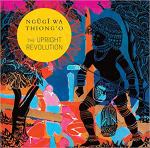|
This section contains 531 words (approx. 2 pages at 400 words per page) |

|
The Upright Revolution Summary & Study Guide Description
The Upright Revolution Summary & Study Guide includes comprehensive information and analysis to help you understand the book. This study guide contains the following sections:
This detailed literature summary also contains Quotes and a Free Quiz on The Upright Revolution by Ngũgĩ wa Thiong'o.
The following version of this story was used to create the guide: Wa Thiong'o, Ngũgĩ. "The Upright Revolution, or Why Humans Walk Upright." Seagull Books, 2019.
In Ngũgĩ Wa Thiong'o's third person mythic tale "The Upright Revolution, or Why Humans Walk Upright," humans once lived like all other four-limbed creatures. The organs were closer together. The limbs also had a different arrangement, allowing them to commune and function like amicable cousins. The legs, feet, hands, and arms could also borrow the capabilities of the sensory organs. While all body parts lived in egalitarian harmony for a time, the organs soon grew jealous of the limbs' special ability to coordinate. They were even more irritated by the limbs' habit of taking their unique capacities. So frustrated, the organs decided to pit the limbs against one another.
Tongue took Brain's idea and announced a contest. Legs and Toes would compete against Arms and Hands. The organs would judge which of the limbs was stronger and better than the others. Wind spread word of the event, and soon every creature and plant in the woods, sky, and water gathered in a forest clearing near a river to witness the competition.
Mouth sang a song to open the event. Then Arms and Hands told Legs and Feet they must pick up a piece of wood and throw it as far as possible. The lower limbs quickly grew frustrated. They could not collect the stick no matter how hard they tried. They kicked the piece of wood a mere couple of inches. Everyone laughed and jeered. Arms and Hands became pompous, delighted by their competitors' failure. They then performed an elaborate display of dexterous skills, impressing judges and spectators alike. Legs and Feet felt sorry for themselves. They did not know how to beat their opponent.
Finally they told Arms and Hands to carry the body around a circle in the sand without the help of the other limbs. Fingers scoffed, believing the challenge was silly and simple. As soon as Hands turned the body upside down, however, they discovered how impossible it was to move themselves without the lower limbs' assistance. Worse, Eyes and Mouth filled with sand. They tried and tried, eventually giving up. Then Legs became arrogant, dancing and leaping about.
Suddenly everyone noticed that something about Thumbs had changed. They were now stretched wide onto the sides of Hands. Instead of inhabiting Hands' function, however, Thumbs' new position aided Hands' dexterity. The change inspired a new discussion amongst the limbs and organs. They wondered at the real definition of the body, eventually deciding they all had to work together. Thus began the upright era.
As two-legged creatures, humans quickly grew in strength and power. Hands, Feet, Legs, Arms, Mouth, and Head all had distinct and vital functions. Every organ and limb understood their importance, and validated the importance of the others. They realized they must be careful to preserve their communication, lest they return to their old four-limbed ways. They all listened to one another, and when Mouth spoke, they spoke for every body part. They were sure not to let Head rule over all of them.
Read more from the Study Guide
|
This section contains 531 words (approx. 2 pages at 400 words per page) |

|



